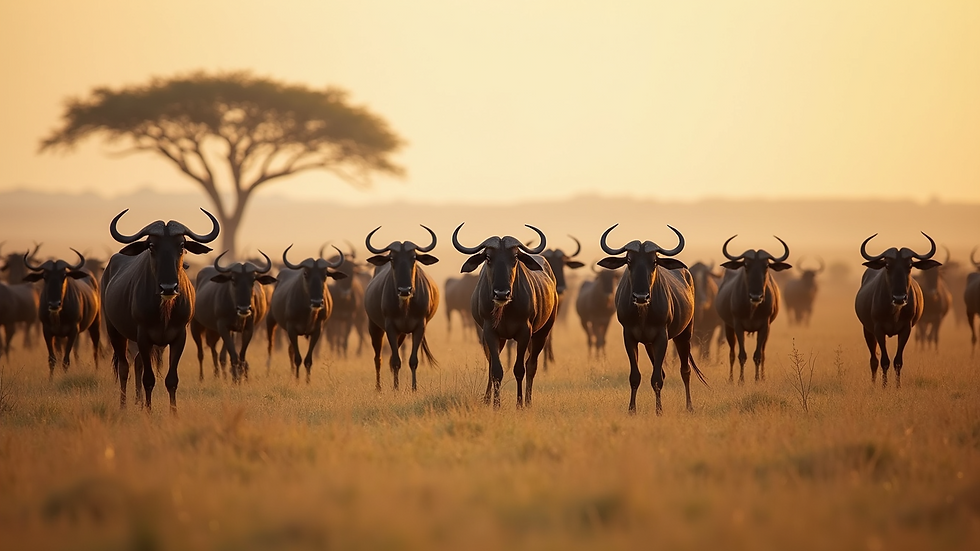Explore Guided Masai Mara Safari Tours
- nyotatours
- Jun 19
- 4 min read
The Masai Mara National Reserve is one of the most spectacular wildlife destinations in the world. Nestled in southwestern Kenya, it offers breathtaking landscapes, diverse ecosystems, and the chance to see the famous "Big Five" in their natural habitat. Guided safaris are a fantastic way to explore this incredible region. Let’s dive into what you can expect from Masai Mara safari tours, the best time to visit, and tips for making the most of your adventure.
Masai Mara Safari Tours
A guided Masai Mara safari tour is an immersive experience. When you join a tour, you're not just a spectator; you become part of the intricate web of life in the African savanna. Over 95 species of mammals and reptiles live in Masai Mara, making each game drive unique. Your guides come equipped with knowledge and experience, ensuring that you not only see wildlife but also understand their behaviors and habitat.

The Best Time to Visit
Timing your trip to Masai Mara is crucial. The dry season, from late June to October, is ideal for wildlife viewing. During this period, animals gather around water sources, making it easier for you to spot them. Additionally, this is when the Great Migration occurs, where millions of wildebeest and zebras traverse the plains in search of greener pastures. This natural spectacle draws tourists from around the globe.

Conversely, the wet season, from November to May, brings lush green landscapes and fewer tourists, but the wildlife can be more dispersed. It's also an excellent time for birdwatchers, as migratory species arrive in the reserve. However, be prepared for occasional rain showers.
What to Expect on Your Guided Tour
During guided safari tours, you can expect a variety of activities. Morning and afternoon game drives offer two prime opportunities to observe wildlife. These excursions typically last 3-4 hours and are led by expert guides in specially designed safari vehicles. The open roof of these vehicles allows you to have an unobstructed view of the surrounding landscape.
Some tours also include walking safaris, where you can explore smaller areas of the reserve on foot. This experience brings you up close with flora, insects, and smaller animals, offering a different perspective of the ecosystem.

Essential Gear for a Safari
Packing the right gear is essential for a successful safari experience. Here’s a checklist of items you may need:
Binoculars: A good pair is crucial for spotting distant animals. Invest in a quality brand that provides clear vision.
Camera: Capture the beauty of the wildlife and landscapes. A zoom lens can help you take breathtaking close-ups.
Comfortable Clothing: Neutral-toned outfits that blend into the surroundings can optimize wildlife viewings. Layering is also recommended for varying temperatures throughout the day.
Sunscreen and Insect Repellent: Protect your skin from harmful UV rays and insect bites, especially during the warm hours.
Water Bottle: Stay hydrated, as the climate can be hot during the day.
Understanding the Masai Culture
While exploring the reserve, you'll also have opportunities to learn about the indigenous Masai people. Many guided tours include visits to traditional Masai villages, where you can experience their unique customs and lifestyle. Engaging with the residents, you might witness traditional dances, learn about their sustainable farming practices, and even buy handmade crafts as souvenirs.
This cultural experience enriches your trip and fosters a deeper appreciation for the land's history and the people who call it home.
Tips for Respectful Wildlife Viewing
Participating in a guided safari requires respect for the wildlife and their habitats. Here are some tips to ensure your safari experience is responsible and enjoyable:
Follow Your Guide’s Instructions: Guides are trained professionals. They know how to safely navigate the environment and keep both you and the animals safe.
Do Not Feed the Animals: Feeding disrupts the natural behavior of wildlife and could lead to dangerous encounters.
Keep a Safe Distance: Use your binoculars and camera zoom rather than approaching animals. This keeps you safe and minimizes stress for the animals.
Leave No Trace: Respect the environment by not littering or disturbing natural habitats.
Making the Most of Your Safari Experience
To truly enjoy your guided Masai Mara safari tours, keep an open mind and remain patient. Wildlife can be unpredictable. Dedicate time to simply sit and observe the landscape. You might spot a cheetah on the hunt or a herd of elephants crossing the plains.
Lastly, booking your tour in advance can often save you money and ensure you secure your desired dates. Research different companies that offer masai mara tours and read reviews to select one with a good reputation.
Final Thoughts
Embarking on a guided safari in Masai Mara is more than just a holiday; it’s an adventure of a lifetime filled with unforgettable moments and profound connections to nature. With breathtaking landscapes, remarkable wildlife, and insights into Masai culture, each aspect of the tour is a reminder of the beauty and delicacy of life on Earth.
So, gather your gear, find a knowledgeable guide, and prepare to immerse yourself in one of the planet's most extraordinary ecosystems. Your journey awaits!









Comments